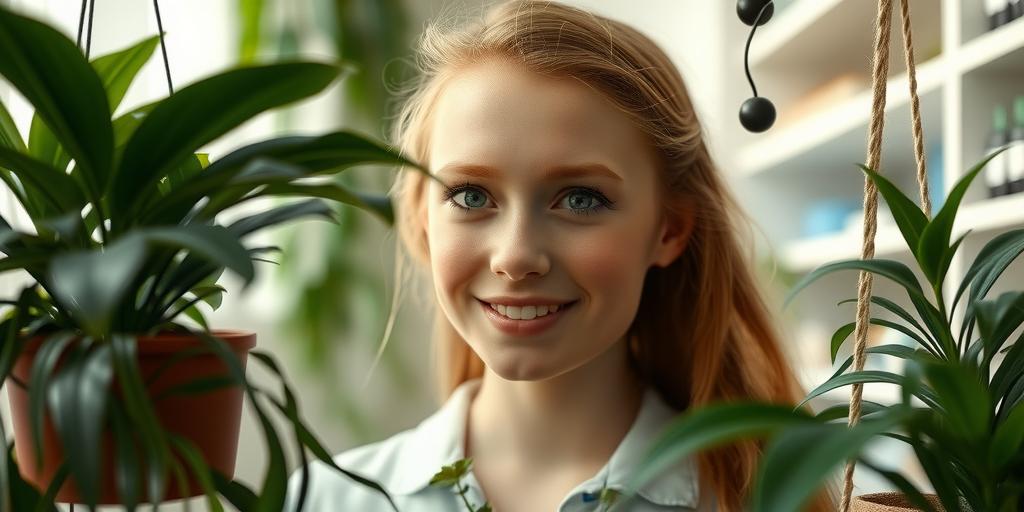
10 Non-Toxic Hanging Plants for Low Light: Safe for Pets (2025)
Looking for pet-safe hanging plants that thrive in low light? Discover 10 non-toxic, easy-care options to beautify your home without risking your furry friends’ health!
Introduction
Did you know that over 30% of houseplants are toxic to pets? If you’re a plant lover with cats or dogs, finding safe, low-light hanging plants can be tricky. But don’t worry—we’ve got you covered! Whether your space lacks sunlight or you just want to add some greenery without the risk, this guide highlights 10 beautiful, non-toxic hanging plants perfect for dim corners and pet-friendly homes. Let’s dive in!
The Dangers of Toxic Plants for Pets
If you share your home with furry friends, choosing non-toxic hanging plants is a must. Many common houseplants contain compounds that can be harmful—or even deadly—to cats and dogs. Symptoms of plant poisoning in pets can range from mild irritation (like drooling or vomiting) to severe reactions (such as difficulty breathing, seizures, or organ failure).
Some notorious toxic plants include pothos, philodendrons, and certain ivy varieties. Even a small nibble can lead to an emergency vet visit. That’s why opting for pet-safe plants like spider plants or Boston ferns gives you peace of mind while still enjoying lush greenery.
Benefits of Hanging Plants in Low-Light Spaces
Not every room gets bright, direct sunlight—but that doesn’t mean you have to skip houseplants altogether. Hanging plants in low-light areas offer several advantages:
-
Improved Air Quality: Many low-light plants, like spider plants and peperomias, help filter indoor air pollutants.
-
Aesthetic Appeal: Trailing vines and cascading foliage add texture and life to dim corners, shelves, or shaded windows.
-
Space-Saving: Hanging planters free up floor and surface space, making them ideal for small apartments or cluttered rooms.
How Low-Light Plants Adapt to Indoor Conditions
Plants that thrive in low light have evolved to survive under tree canopies or in shaded forest floors. They typically have:
-
Larger, Darker Leaves: More surface area helps them absorb limited light efficiently.
-
Slow Growth Rates: Less light means slower photosynthesis, so these plants don’t demand frequent pruning or repotting.
-
Drought Tolerance: Many low-light varieties (like cast iron plants) can handle irregular watering, making them forgiving for forgetful plant parents.
10 Best Non-Toxic Hanging Plants for Low Light
1. Spider Plant (Chlorophytum comosum)
Spider plants are a classic choice for pet owners—they’re completely safe for cats and dogs. These hardy plants thrive in indirect light and can even tolerate occasional neglect. One of their coolest features? They produce “spiderettes,” or baby plants, which dangle from long stems. You can snip these off and propagate them easily in water or soil.
2. Boston Fern (Nephrolepis exaltata)
If you want a lush, feathery look, Boston ferns are perfect. They’re non-toxic and love humidity, making them great for bathrooms or kitchens. While they prefer indirect light, they can adapt to lower light levels—just keep the soil consistently moist and mist them occasionally.
3. Staghorn Fern (Platycerium bifurcatum)
Staghorn ferns are unique epiphytes (air plants) that grow naturally on trees. Their antler-like fronds make a striking statement, whether mounted on wood or hung in a basket. They tolerate low to medium light and prefer occasional misting over heavy watering.
4. Peperomia (Peperomia spp.)
Peperomias come in dozens of varieties, many of which are compact and perfect for hanging planters. The Peperomia obtusifolia (baby rubber plant) is especially low-light tolerant. These plants have thick, waxy leaves that store water, so they’re forgiving if you forget to water them now and then.
5. Swedish Ivy (Plectranthus verticillatus)
Despite its name, Swedish ivy isn’t a true ivy—and it’s completely safe for pets. This fast-growing plant has trailing stems with rounded, scalloped leaves. It adapts well to low light, though it may grow more slowly than in brighter spots. Let the soil dry slightly between waterings to prevent root rot.
6. Ponytail Palm (Beaucarnea recurvata)
The ponytail palm isn’t a palm at all—it’s a succulent! Its long, curly leaves cascade beautifully from hanging baskets, and its bulbous trunk stores water, making it drought-tolerant. It thrives in bright to low indirect light and only needs watering every few weeks.
7. Cast Iron Plant (Aspidistra elatior)
True to its name, the cast iron plant is nearly indestructible. It can survive deep shade, irregular watering, and even poor air quality—all while being safe for pets. Its dark green, strappy leaves add a tropical touch to any space.
8. Prayer Plant (Maranta leuconeura)
Prayer plants are known for their striking, patterned leaves that fold upward at night (a phenomenon called nyctinasty). They prefer low to medium indirect light and higher humidity, so they’re great for terrariums or humid rooms. Plus, they’re completely non-toxic to pets.
9. Baby’s Tears (Soleirolia soleirolii)
This delicate, creeping plant forms a dense mat of tiny green leaves, making it ideal for hanging planters or terrariums. It loves humidity and low light, though it does need consistent moisture to thrive. Just keep it away from curious pets who might be tempted to dig in its soft foliage.
10. Burro’s Tail (Sedum morganianum)
A succulent with long, trailing stems covered in plump leaves, burro’s tail is a stylish choice for hanging baskets. It’s safe for pets and requires minimal care—just give it occasional water and bright to low indirect light. Be gentle when handling it, though, as the leaves can drop easily.
Tips for Growing Hanging Plants in Low Light
Best Placement for Low-Light Conditions
-
North-Facing Windows: These provide consistent, gentle light without harsh sun exposure.
-
Shaded Corners: Choose spots a few feet away from windows where light is diffused.
-
Bathrooms: Many low-light plants (like ferns) thrive in the humidity from showers.
Watering and Humidity Tips
-
Check Soil Moisture: Stick your finger an inch into the soil—water only if it feels dry. Overwatering is a common issue in low-light settings.
-
Use a Humidifier: Many tropical plants appreciate extra humidity, especially in dry homes.
-
Mist Occasionally: A light spritz helps plants like prayer plants and ferns stay happy.
Preventing Pests in Low-Light Environments
-
Avoid Overwatering: Soggy soil attracts fungus gnats and mold.
-
Wipe Leaves: Dust can block light absorption—clean leaves with a damp cloth.
-
Inspect Regularly: Check for pests like spider mites, especially in dry conditions.
Choosing the Right Hanging Planters
-
Material: Lightweight plastic or macramé hangers work well for small spaces; ceramic adds weight but looks stylish.
-
Drainage: Ensure pots have drainage holes to prevent root rot.
-
Size: Match the planter to the plant’s root system—too large, and soil stays wet too long.
With these tips and plant picks, you can create a thriving, pet-friendly jungle—even in the dimmest corners of your home!
Conclusion
Transforming your home with non-toxic hanging plants doesn’t have to be hard—even in low light! From the easy-care Spider Plant to the elegant Boston Fern, these pet-safe options bring life to any space without the worry. Ready to greenify your home? Pick your favorites and start hanging!
